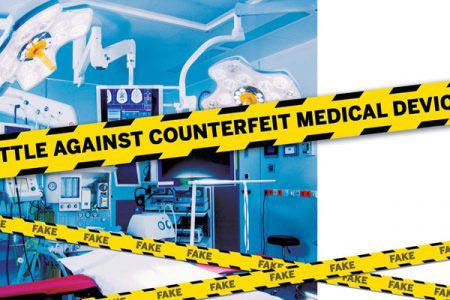|
Why Anticounterfeit Packing
for Medical Devices?
|

Bhupesh Sood
Business Head, SECGLOBAL |
By Bhupesh Sood (MBA, WHO – AAR ,
Certified Six Sigma Green Belt, Data Science
Foundation, MDR 2017, ISO 13485, ISO 9001, ISO 14001,
ISO 45001, WCA)
WHO defines Counterfeit as:A
counterfeit medicine is one which is deliberately and
fraudulently mislabelled with respect to identity
and/or source. Counterfeiting can apply to both
branded and generic products and counterfeit products
may include products with the correct ingredients or
with the wrong ingredients, without active
ingredients, with insufficient (inadequate quantities
of ingredient(s) or with fake packaging.
It is widely accepted that counterfeiting
medical devices is a threat to the
patient safety. With regulators becoming more
stringent, the requirements must be adhered to , to
stay in business, for a longer duration. |
Universally, falsifying is thought to
represent one to two percent of worldwide exchange. The
secretive idea of forging makes it difficult to precisely
measure the size of the fake clinical gadget issue in the
United States. While some exploration shows that up to
eight percent of clinical gadgets are fake all around, it
is exceptionally improbable that the figure is that high
inside the U.S.
 While
exact estimation is difficult, the documented seizures
statistics from the Department of Homeland Security, FDA
recalls, and highly publicized counterfeit discoveries,
nonetheless provide evidence of widespread counterfeit
proliferation within the legitimate supply
chain.Anticounterfeit measures secure both the maker and
the end customer. A counterfeit medical device, when used,
places the patient at serious risk and impacts the maker
through potential loss of reputation, cost of removing
these phony product out of the system and additional
effort to prevent further issues occurring. While
exact estimation is difficult, the documented seizures
statistics from the Department of Homeland Security, FDA
recalls, and highly publicized counterfeit discoveries,
nonetheless provide evidence of widespread counterfeit
proliferation within the legitimate supply
chain.Anticounterfeit measures secure both the maker and
the end customer. A counterfeit medical device, when used,
places the patient at serious risk and impacts the maker
through potential loss of reputation, cost of removing
these phony product out of the system and additional
effort to prevent further issues occurring.
Another major challenge is
anti-diversion. This is to ensure that products that have
been developed for a specific market, perhaps with
materials that are not allowed in other countries but are
authorized for the intended market, validated, compliant
and fit for purpose, are not removed from the supply
chain, repackaged and sent into a country that should not
receive that item. It can be potentially dangerous for
patients and is illegal. Therefore, the challenge is to
avoid both counterfeit and diverted products.
Passive methods apply to the packaging.
Medical devices have 3 levels of packaging: The primary
packaging (pouch), which then goes into a secondary box
(product box) and finally packaged into a shipper where
there will be multiple products stored in one package.
To abstain from duplicating, producers
can apply obstructions to every one of these things of
bundling. Regardless of whether that be a 3D image, UV ID
code, 2-D scanner tag with one of a kind
numbering/serialization or shrouded content printed
utilizing security or attractive ink. These are not
planned as end-client checks yet as impediments to the
forger. A prepared individual can rapidly build up if the
item is bona fide and can take things further by
referencing the one of a kind numbers utilized in the
security checking through a confirmation site.
A unique serial number or reference
number (URN) is a randomized number printed onto the
product’s packaging and as it’s unique, it can be used to
define exactly who manufactured the item, where it was
manufactured and the country of origin. This sort of
serialization at the device level is crucial in the battle
against forging. Serialization not just enables to confirm
the item as authentic, yet additionally offers the
capacity to follow item development all through the
production network, improve effectiveness and in
particular, secure the end client.
Modern technologies can then use the
serialized data in barcode format, which can be scanned at
any point throughout the supply chain and checked with
online systems to verify its authenticity. In the event
that the look-into returns with no read/copy, at that
point we know there is an issue with the device and it
tends to be dismissed out of the production network and
extra activity taken to expel these fake devices. These
techniques unmistakably work, are basic and financially
savvy to execute.
Conclusion
Organizations need to make sure that
they put into practice the correct systems and processes
that can support them in meeting global standards and
country-specific requirements now and in the future.
Implementing a fit-for-purpose validated labeling solution
with in-built serialization capabilities, which can
provide very high volumes of unique, secured and
“intelligent” serial numbers for this process would
therefore be vital.
Reference.
1. Keeping up with Counterfeiters: The
Battle Against Counterfeit Medical Devices By Steve
Ellison , Steve Ellison, PRISYM ID
(
https://www.medtechintelligence.com/column/keeping-upwith-counterfeiters-the-battle-against-counterfeit-medicaldevices/
)
2. Unifying Efforts against
Counterfeiting Medical Devices, Saudi Food and Drugs
Authority Initiative, Nazeeh Alothmany, PhD, Vice
Executive President for Medical Devices and Equipment,
Saudi Food and Drugs Authority, Third WHO Global Forum on
Medical Devices Geneva, May 9th-12th, 2017
3. Barry McDonogh, Vice President of
Business Development, TruTag Technologies Inc.
(
https://www.mpo-mag.com/contents/view_online-exclusives/2016-05-05/combatting-counterfeiting-in-medtech/
)
********************************************************************************
Bhupesh Sood (MBA,
IPR - WIPO (Switzerland), WHO -
AAR, Trainer and Auditor, Certified Six Sigma Green Belt,
Data Science Foundation, MDR 2017, ISO 13485, ISO 9001,
ISO 14001, ISO 45001, WCA)
********************************************************************************
|
